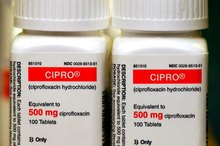Antibiotics Recommended for Infected Wounds
An infection is the growth of a parasitic organism, also called a germ, within the body. The onset of an infection is sudden, causing pain and swelling around the wound. Those germs, more commonly bacteria, attach to the tissues preventing the wound from healing.
The bacteria can also enter the blood through the vein and cause a severe infection or sepsis. The antibiotic is chosen based on the bacteria present. Oral antibiotics are taken by mouth, while IV antibiotics are administered through a needle directly into the bloodstream.
1. Cephalexin
Cephalexin is a semisynthetic cephalosporin antibiotic with a spectrum of antibiotic activity similar to the penicillins 2. It is used in the treatment of infections caused by bacteria, such as urinary tract infections, ear infections and skin infections.
It works by hindering with the ability of the bacterial cells to buildup and repair its cell wall, according to Drugs.com. Cephalexin is not prescribed for patients who are allergic to antibiotics 2.
- Cephalexin is a semisynthetic cephalosporin antibiotic with a spectrum of antibiotic activity similar to the penicillins 2.
2. Amoxicillin
Antibiotics to Treat Tonsillitis
Learn More
Amoxicillin belongs to the penicillin group of beta-lactam antibiotics. It has an effect only on bacterial population and is not effective against non-bacterial infections, such as viral infections.
A member of the penicillin class, amoxicillin does not kill bacteria directly, but rather destroys the cell wall, preventing them from making proteins, which are necessary for them to survive and thrive. Amoxicillin may be useful for infections caused by gram-positive organisms, such as Streptococci and E. coli.
- Amoxicillin belongs to the penicillin group of beta-lactam antibiotics.
- A member of the penicillin class, amoxicillin does not kill bacteria directly, but rather destroys the cell wall, preventing them from making proteins, which are necessary for them to survive and thrive.
3. Augmentin
Augmentin is a member of the penicillin family of antibiotics 4. It is specifically designed to fight penicillin-resistant strains of bacteria. An oral antibacterial combination, augmentin consists of amoxicillin, a semisynthetic penicillin, and clavulanate potassium, a potassium salt 4.
Amoxicillin eliminates bacteria that cause sinusitis, pneumonia, ear infections and bronchitis. As a beta-lactamase inhibitor, clavulanate potassium overcomes granting immunity in beta-lactamase secreting bacteria, thereby counteracting conceivable bacterial resistance to the amoxicillin, according to Drugs.com
Related Articles
References
- Columbia University Medical Center: Wound Healing
- Drugs: Cephalexin
- MedicalNewsToday: What Is Amoxicillin? What Does Amoxicillin Treat?
- Drugs: Augmentin
- Amoxil, Moxatag (amoxicillin) dosing, indications, interactions, adverse effects, and more.
- Soukavong M, Kim J, Park K, et al. Signal Detection of Adverse Drug Reaction of Amoxicillin Using the Korea Adverse Event Reporting System Database. J Korean Med Sci. 2016;31(9):1355-61. doi:10.3346/jkms.2016.31.9.1355
- Stein GE, Gurwith MJ. Amoxicillin-potassium clavulanate, a beta-lactamase-resistant antibiotic combination. Clin Pharm. 1984;3(6):591-9.
- Thomas VM, Thomas-eapen N. An Uncommon Side Effect of a Commonly Used Antibiotic: Amoxicillin-Clavulanic Acid Induced Hepatitis. Korean J Fam Med. 2017;38(5):307-310. doi:10.4082/kjfm.2017.38.5.307
- Millard G. Further experience with augmentin in the treatment of skin infections. Scott Med J. 1982;27 Spec No.:S35-8. doi:10.1177/00369330820270S108
- Blaser M. Antibiotic overuse: Stop the killing of beneficial bacteria. Nature. 2011;476(7361):393-4. doi:10.1038/476393a
- Zaman SB, Hussain MA, Nye R, Mehta V, Mamun KT, Hossain N. A Review on Antibiotic Resistance: Alarm Bells are Ringing. Cureus. 2017;9(6):e1403. doi:10.7759/cureus.1403
- Amoxil, Moxatag (amoxicillin) dosing, indications, interactions, adverse effects, and more.
- Augmentin, Augmentin XR (amoxicillin/clavulanate) dosing, indications, interactions, adverse effects, and more.
Writer Bio
Dr. Scott Fannin has been writing professionally since 2002. His articles appear in “WebMD”, “The American Journal of Managed Care” and “American Medical News.” He obtained a bachelor's degree in physiology from Washington State University and Doctor in Osteopathic Medicine from Pacific Northwest University of Health Sciences.









